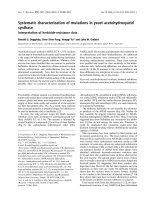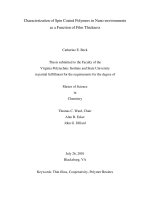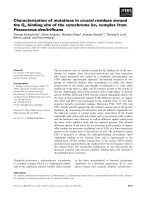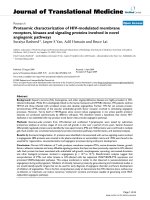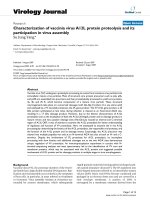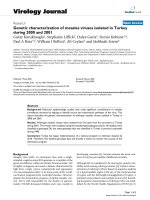Characterization of volatiles in unhopped wort
Bạn đang xem bản rút gọn của tài liệu. Xem và tải ngay bản đầy đủ của tài liệu tại đây (407.92 KB, 35 trang )
Seediscussions,stats,andauthorprofilesforthispublicationat: />
ReleaseandEvaporationofVolatilesduring
BoilingofUnhoppedWort
ArticleinJournalofAgriculturalandFoodChemistry·August2008
ImpactFactor:2.91·DOI:10.1021/jf800610x·Source:PubMed
CITATIONS
READS
10
75
7authors,including:
DavidPaulDeSchutter
DaanSaison
AnheuserBuschInbev
AB-Inbev
18PUBLICATIONS384CITATIONS
29PUBLICATIONS455CITATIONS
SEEPROFILE
SEEPROFILE
GuyDerdelinckx
FreddyRDelvaux
UniversityofLeuven
UniversityofLeuven
83PUBLICATIONS1,624CITATIONS
101PUBLICATIONS2,637CITATIONS
SEEPROFILE
Allin-textreferencesunderlinedinbluearelinkedtopublicationsonResearchGate,
lettingyouaccessandreadthemimmediately.
SEEPROFILE
Availablefrom:DavidPaulDeSchutter
Retrievedon:20May2016
1
Identification of Volatiles in Unhopped Wort
2
DAVID P. DE SCHUTTER1*, DAAN SAISON1, FILIP DELVAUX1, GUY
3
DERDELINCKX1,
4
DELVAUX1
JEAN-MARIE
ROCK²,
HEDWIG
NEVEN³,
FREDDY
R.
5
6
1
7
University of Leuven
8
Kasteelpark Arenberg 22 box 02463, 3001 Heverlee, Belgium
9
²Brasserie d’Orval S.A., 6823 Villers-devant-Orval, Belgium
10
Centre for Malting and Brewing Science, Faculty of Bioscience Engineering, Catholic
³Brewery Duvel Moortgat N.V., Breendonkdorp 58, 2870 Puurs, Belgium
11
12
* tel: +32 (0)16 321413; fax: +32 (0)16 321576;
13
14
15
TITLE RUNNING HEADER
16
Volatiles in unhopped wort
17
1
18
ABSTRACT
19
The volatile fraction of wort components was studied during boiling. Not less than 118
20
volatile compounds were identified when un-hopped pilsner wort was boiled and samples
21
of wort and condensed vapors were analyzed with headspace SPME-GC/MS, of which 54
22
were confirmed with reference compounds. The wort samples contained 61 identifiable
23
compounds, while the vapor condensate yielded 108 different compounds. Almost 30
24
known compounds were found that have not been described before in un-hopped pilsner
25
wort, while one previously unknown aldol reaction product was tentatively identified as
26
2-phenyl-2-octenal. The detection of branched 2-alkenals underlines the importance of
27
the aldol condensation in Maillard-type reactions, while the tentative identification of
28
alkyloxazoles and alkylthiazoles could once more accentuate the central role of α-
29
dicarbonyl compounds, aldehydes and amino acids in flavor generation. The
30
condensation of wort vapors joined with the SPME-GC/MS technique has proven to be a
31
useful tool in volatile analysis.
32
33
KEYWORDS
34
Keywords: wort boiling, volatiles, evaporation, condensate, aldehydes, ketones, 2-
35
alkenals, 2-phenyl-2-octenal, oxazoles, thiazoles, furans, Maillard reaction, flavor
36
compounds
37
2
38
INTRODUCTION
39
In the world of brewing technology, no topic is more controversial than wort boiling. The
40
reason for this is simple: wort is a complex mixture of sugars, amino acids, lipids,
41
proteins and polyphenols. Hundreds of reactions occur simultaneously, such as Maillard
42
reactions, lipid oxidation reactions, the thermal decomposition of S-methylmethionine to
43
dimethylsulfide and the isomerization of hop α-acids into iso-α-acids. Unfortunately, it is
44
not yet known to which extent every single reaction accounts for the quality of the final
45
product and the flavor stability of the beer during storage.
46
Brewing researchers agree that the reduction of thermal load during wort boiling
47
improves beer flavor stability (1,2). Apart from that, the evaporation of dimethylsulfide is
48
often the sole quality criterion used by suppliers to prove the value of their wort boiling
49
system. Progress in this field can only be made through a more profound knowledge of
50
the presence of the volatiles in wort and the chemical background of these compounds. In
51
the past, analysis of volatiles has already been carried out on malt extract (3), ale malt
52
(4), caramel malts (5), roasted malts (6), ale wort (7) and on pilsner-type beer (8,9). Other
53
papers focused primarily on odor-active compounds of hops in beer (10) or described
54
new techniques to identify more than 120 different compounds in hop oil, while probably
55
over 1,000 compounds are still waiting to be discovered in the hop oil fraction (11).
56
The presence of these abundant hop volatiles in wort could impede a proper detection and
57
identification of the malt-derived and boiling process related volatiles. Therefore, it was
58
decided to investigate the flavor profile of un-hopped pilsner wort together with the
59
condensate of the vapors generated while boiling. The advantage of the analysis of vapor
60
condensates is obvious: volatiles are generally enriched in the vapor phase, depending on
3
61
the volatility of the particular compound. If this flavor-rich mixture is combined with a
62
very sensitive analysis technique, such as solid-phase micro-extraction (SPME) in
63
combination with GC/MS (12,13), a powerful identification tool is created. The increased
64
sensitivity offers opportunities for the detection of new compounds in wort and
65
consequently, fur unraveling new reaction pathways that may occur during boiling. As
66
the volatility of every volatile compound is determined and expressed by its vapor-liquid
67
equilibrium (14), there must be a strict correlation between the presence of a compound
68
in the condensate and in the wort. Variations in wort will therefore be reflected in the
69
vapor condensate.
70
The purpose of the present study is the identification of a broad range of volatiles in order
71
to obtain a better understanding of the chemical background of unhopped wort. A crucial
72
factor in this identification is obtaining an increased sensitivity for the identification of
73
novel compounds. Therefore the SPME GC/MS technique is combined with the analysis
74
of wort vapor condensate, a combination that should greatly enhance the analysis
75
sensitivity.
76
In the present study, we used the SPME-GC/MS technique for the detection and
77
identification of volatiles in un-hopped pilsner wort and vapor condensates of the same
78
wort. The chemical background of some of the detected compounds is further
79
investigated and a comparison is made with data found in literature. New compounds
80
found in the un-hopped wort are discussed in detail.
81
MATERIALS AND METHODS
82
Chemicals
4
83
Methyl isobutyl ketone RECTAPURTM was bought from VWR International (West
84
Chester, PA). The compounds 2-pentylfuran (98 %) and (E,E)-2,4-decadienal (90 %)
85
were obtained from Alfa Aesar GmbH (Karlsruhe, Germany). All other chemicals were
86
acquired from Sigma-Aldrich (St. Louis, MO, USA): isobutyraldehyde, 2-phenyl-2-
87
butenal, (E)-2-nonenal, 5-hydroxymethyl-2-furfural (HMF), decanal, 5-methyl-2-furfural,
88
3-methylthiopropionaldehyde,
89
dimethyltrisulfide (DMTS), 2-ethyl-3,5(or 6)-dimethylpyrazine, 5-methyl-2-phenyl-2-
90
hexenal, 4-methyl-2-phenyl-2-pentenal, 2-acetylfuran, 2-isopropyl-5-methyl-2-hexenal,
91
2-methylpyrazine,
92
diacetyl, 2,3-pentanedione, β-myrcene, dimethylsulfide, β-damascenone, 4-vinylguaiacol,
93
hexanal, 2-heptanol, phenylethylalcohol, 3-methylbutanol, 1-hexanol, isovaleric acid, 2-
94
furfural, heptanal, propanal, furfuryl alcohol, pentanal, benzaldehyde, 2-methylbutanal,
95
octanal, butanal, isoamyl acetate and γ-nonalactone.
96
Wort production
97
Wort production was performed in the pilot scale (5 hl) brewery of the Centre for Malting
98
and Brewing Science (Heverlee, Belgium). An amount of 80 kg milled pilsner malt
99
(Dingemans, Stabroek, Belgium) was added to 220 liters of water at 55°C. The pH was
100
adjusted to 5.5 with lactic acid and the mash was subjected to a rest of 10 min. Next, the
101
temperature was raised to 63°C (35 min of rest) and the saccharification temperature of
102
72°C (20 min). After the saccharification rest, the mash was heated up to 78°C and
103
subsequently transferred to the lauter tun, in which the separation of spent grains and
104
sweet wort takes place. The filtered sweet wort was collected in the boiling kettle, where
105
it was heated up to 90°C. At 90°C, the wort was taken in 1.5L containers and
nonanal,
(E)-2-hexenal,
2,3-diethyl-5-methylpyrazine,
3-methylbutanal,
phenylacetaldehyde,
α-linalool,
5
106
immediately cooled down to room temperature. Hereafter the containers with sweet wort
107
were frozen at -25°C. Prior to the boiling experiments, the wort was defrosted; the
108
density was adjusted to 12°P and the pH was adjusted to 5.2 with sulfuric acid.
109
Lab-scale boiling
110
The boiling device consisted of a 6L stainless steel vessel, equipped with a wort sample
111
valve, a paddle stirrer and a temperature sensor, which was immersed in the wort. A glass
112
cover was used with inlets for the paddle stirrer, the temperature sensor and an outlet
113
chimney for wort vapors. A Liebig-cooler (cooling water at 2°C) was placed on the outlet
114
in order to condense the produced vapors. This condensate was collected in 50 ml tubes
115
on ice. The heating device consisted of a stainless steel plate with an integrated
116
temperature sensor and feed back temperature regulation was performed with the
117
immersed temperature sensor. While boiling, the heating plate temperature was kept
118
constant to guarantee uniform heating during the boiling experiment, while continuous
119
stirring ensured a homogenous heat distribution.
120
Sample preparation and Solid-Phase Micro-Extraction (SPME)
121
A 20 mL headspace vial was filled with a 10 mL aliquot of wort or vapor condensate,
122
together with 3.5 g NaCl (analytical grade) and 50 µL of a 200 ppm 2-heptanol solution,
123
used as an internal standard. The vial was placed in the tray of the CombiPAL (CTC
124
Analytics, Zwingen, Switzerland), where it was pre-incubated at 40°C for 10 minutes.
125
Hereafter a carboxen-polydimethylsiloxane-divinylbenzene fiber (CAR-PDMS-DVB,
126
Supelco, Bellefonte, PA) was used for extraction of volatiles in the headspace of the vial
127
during 20 min at 40°C.
128
GC/MS analysis
6
129
The injection of the CAR-PDMS-DVB fiber was performed in a split/splitless injector of
130
a Trace GC Ultra (Thermo, Waltham, MA) and desorption was executed for 2 minutes at
131
250°C in split mode (with a split ratio of 8). The used columns were of the type RTX-
132
200MS (30m, 0.25mm ID, 0.5µm df) and of the type RTX-5SilMS (60m, 0.25mm ID,
133
1.0µm df), both from Restek (Bellefonte, PA). A constant flow of 1.5 ml He per minute
134
was applied in both cases. The following temperature program was used with the RTX
135
200MS column: 30°C for 2 min, followed by a 3°C/min increase to 120°C, then a
136
10°C/min rise to 200°C, and finally with a 30°C/min rise to 260°C with a 1 min hold.
137
The following temperature program was used with the RTX 5SilMS column: 30°C for 2
138
min, then a rise to 70°C at a rate of 10°C/min with 1 min hold, followed by a rise up to
139
200°C at a rate of 4°C/min, and finally up to 270°C at a rate of 20°C/min, with a 2 min
140
hold. After separation, the volatiles were analyzed with a Dual Stage Quadrupole (DSQ)
141
MS (Thermo, Waltham, MA), which was set to detect positive ions with a mass to charge
142
ratio (m/z) of 33-260 in the electron-impact mode. The data were analyzed using
143
Xcalibur software (Thermo, Waltham, MA).
144
Identification of volatiles
145
The identification of wort volatiles was performed by GC-MS spectral analysis and their
146
Kovat’s retention indices were calculated for a RTX-200MS column and a RTX-5MS
147
column. Where possible, chemical standards were injected and compared with identified
148
compounds.
149
Aldol condensation reactions
150
De-ionized water was supplemented with 500 ppb of each reagent. The pH was adjusted
151
to pH 5.2 with lactic acid and 20 ml of the solution was incubated in sealed pyrex tubes
7
152
for 1 hour in a water bath at 100°C (in duplicate). After incubation, the samples were
153
cooled on ice and prepared for SPME-GC/MS analysis as described above.
154
RESULTS AND DISCUSSION
155
Headspace SPME GC/MS is a very sensitive technique for trace compound analysis in
156
the headspace of beverages, without the need for preliminary extraction and
157
consequently, without the risk of losing information with time-consuming extraction
158
procedures (13). The only consideration that has to be made is the choice of the
159
appropriate fiber. In this case, a 3-phase CAR-PDMS-DVB fiber was chosen in order to
160
obtain the broadest extraction spectrum of volatiles.
161
When wort is boiled, an important concern of the brewer is the quality of the wort after
162
boiling. The evaporated fraction of the wort is of minor importance, except for energy
163
recuperation by condensation. However, wort vapors contain high levels of volatiles due
164
to the higher volatility of those compounds in comparison with the volatility of water.
165
Therefore, the condensed vapors contain volatiles in levels that are related of the levels of
166
those volatiles in the remaining wort. Hertel and coworkers have determined the vapor-
167
liquid equilibrium of dimethylsulfide as 75.6, whereas the vapor-liquid equilibrium of
168
phenylacetaldehyde is no more than 5.6 (14). Hence analyzing the condensed vapor
169
fraction of the wort reveals more information than analysis of the same wort. The
170
difference in sensitivity is illustrated in Error! Reference source not found.1. While only
171
4 peaks have an intensity of more than 107 in wort (Chromatogram A), there are more
172
than 20 peaks with the same intensity in the condensate (Chromatogram B). Therefore it
173
was chosen to take samples from pilsner wort during boiling, as well as from the vapors
174
produced during the same wort boiling. The vapors were collected in subsequent
8
175
fractions, the first condensate fraction containing the highest total concentration of
176
volatiles as a mirror of the high content of volatiles in the un-boiled wort.
177
The volatiles that were identified in the wort and vapor condensates are shown in Table
178
1. In the un-hopped wort, it was possible to identify 61 volatile compounds: 6 sulfur
179
compounds, 10 furans, 11 linear aldehydes, 2 esters, 14 ketones, 8 alcohols, 4 branched
180
2-alkenals, 2 pyrazines, a terpenoid compound, an acid, a lactone and a phenolic
181
compound. On the other hand, analysis of the vapor condensate revealed 114 identifiable
182
compounds: 6 sulfur compounds, 14 furans, 13 linear aldehydes, 5 esters, 18 ketones, 14
183
alcohols, 19 2-alkenals, 13 pyrazines, 5 terpenoids, 2 oxazoles, 3 thiazoles, 1 lactone and
184
a phenolic compound. Some of these compounds have never been reported before as part
185
of the volatile fraction of un-hopped wort or even in beer. One previously unidentified
186
compound, 2-phenyl-2-octenal, was identified by mass spectral analysis and confirmed
187
by experiments with a model solution. This compound was never reported before in
188
literature, to the best of our knowledge.
189
190
Sulfur compounds. Methanethiol is generated from the degradation of methional or
191
methionine by a retro-Michael reaction and two molecules of methanethiol can further
192
associate to yield dimethyldisulfide (15). The compound dimethylsulfide is one of the
193
most important quality parameters for brewers while boiling. It is formed by the thermal
194
decomposition of S-methylmethionine (16). The flavor threshold of this compound is
195
around 50 ppb and in high concentrations it has an unpleasant, cooked cabbage flavor.
196
Thiophene is obtained as a result of the reaction of cysteine with Maillard reaction
197
products (17). Dimethyltrisulfide was easily detected in both wort and condensate,
9
198
despite of the general belief that this flavor compound belongs to the typical constituents
199
of the hop oil fraction (18). However, analogous to the production of dimethyldisulfide,
200
dimethyltrisulfide can also be formed from methional, as this process was observed
201
during beer aging as well (19). Dimethyltetrasulfide, a known compound in hops (20),
202
has never been detected before in non-hopped beer constituents. The level of
203
dimethyltetrasulfide in wort was very low as this compound was only detectable in the
204
vapor condensate.
205
206
Furans. Furans have always been associated with the Maillard reaction as this pathway is
207
one of the main furan-generating pathways. Furfuryl alcohol (and to a lesser extent 2-
208
furfural) is known as a precursor of furfuryl ethyl ether, an important beer staling
209
compound in beer (2,21). Furfural and 5-hydroxymethylfurfural are generally considered
210
as important beer aging markers (22). Acetylfuran and 5-methyl-2-furfural also tend to
211
accumulate during beer aging (23) and their formation is due to the Maillard reaction as
212
well. The alkylfurans 2-methylfuran, 2-ethylfuran and 2-pentylfuran have already been
213
observed in malt (4) and wort (7), while 2-butylfuran has only been reported in malt
214
extract (3). Pentylfuran, with a “cough syrup”-like flavor characteristic, is recognized as a
215
product of lipid oxidation and formed by a ring closure of 4-hydroxy-2-nonenal (24).
216
Subsequently 2-butylfuran could be formed in an analogous manner starting from 4-
217
hydroxy-2-octenal, and 2-ethylfuran could be formed starting from 4-hydroxy-2-hexenal
218
as well (Figure 1). Both possible precursors of 2-butylfuran and 2-ethylfuran have
219
previously been detected in vegetable oil (25). As these precursors have a polar nature,
10
220
they will not easily be evaporated. Only after ring-closure a more volatile compound is
221
generated, which can be evacuated by evaporation.
222
The compounds (E)- or (Z)-2-(2-pentenyl)-furan and 3-phenylfuran were tentatively
223
identified. While 2-(2-pentenyl)furan has only been reported in the volatile fraction of
224
cooked pork (26), the presence of 3-phenylfuran has already been observed in the volatile
225
fraction of chocolate and its flavor was described as cocoa, green or mint (27). The
226
tentatively identified 2-hexanoylfuran has never been described in food-related literature
227
so far.
228
229
Linear Alkanals and Strecker Aldehydes. The listed aldehydes were all identified and
230
compared with their reference compounds. The well-known Strecker aldehydes (2-
231
methylpropanal, 2-methylbutanal, 3-methylbutanal, methional, phenylacetaldehyde and
232
benzaldehyde) are considered as aging-relevant compounds and are frequently used as
233
indicators for wort boiling performance (1). The parent amino acids of the Strecker
234
aldehydes are easy to determine, except for benzaldehyde, as there is no direct correlation
235
between benzaldehyde and any available amino acid. Granvogl et al. (28) suggested an
236
imine-enamine
237
methylglyoxal, followed by the oxidation of the intermediate and a retro-aldol reaction,
238
generating benzaldehyde and formaldehyde. Phenylethylamine can be formed out of
239
phenylalanine. Consequently, direct formation of benzaldehyde from phenylalanine could
240
occur analogously with an additional decarboxylation step.
241
The linear alkanals have already been described many times in wort (29) and beer (30).
242
They originate from the enzymatic oxidation of fatty acids during the mashing process or
tautomerization
of
the
Schiff-base
of
phenylethylamine
and
11
243
from chemical autoxidation reactions during the wort boiling process. One of the most
244
flavor active compounds is (E,E)-2,4-decadienal, which is formed by oxidation of linoleic
245
acid and which is characterized by an unpleasant ‘fried oil’ flavor (31). The oxidized
246
form of (E,E)-2,4-decadienal, the 4,5-epoxy-2-decenal derivative, could also directly be
247
involved in a Strecker-type reaction with amino acids (32).
248
249
Esters. The identified esters probably originate from the barley malt. The tentatively
250
identified isopropyl laurate (characteristic ions 183, 200, 201) was never encountered
251
before in beer or wort. Strikingly this compound was not only detectable in the vapor
252
condensate, but in wort as well.
253
254
Ketones. Eighteen ketones were identified in the vapor fraction of the wort. Among them
255
β-damascenone was found, which could either be generated by hydrolysis of glycosides
256
(33) or by direct oxidation of carotenoids (34). Together with β-damascenone, its direct
257
precursor 3-hydroxy-β-damascone was tentatively identified for the first time in the wort
258
volatile fraction. Acetophenone was found in both wort and vapor fraction. Its presence
259
has already been observed in Maillard model systems (35). The presence of different
260
isomers of 3,5-octadien-2-one was also encountered for the first time in wort or beer.
261
Presumably this compound originates from lipid oxidation like most of the ketones listed.
262
The cyclic ketone 4-cyclopentene-1,3-dione was tentatively found for the first time in
263
wort and vapor condensate, since no reference compound is commercially available. The
264
compound has been described as quantitatively the most important carbonyl compound in
265
melanoidin degradation model systems (36) and its formation pathway has been proposed
12
266
by Yaylayan et al. (37). This pathway starts from a phosphorylated D-glucose, which is
267
converted to 3-deoxyglucosone-6-phosphate.
268
reaction a 1,2,4-tricarbonyl compound is generated.
269
undergoes cyclization via an intra-molecular aldol condensation. However it is not yet
270
known whether this compound could contribute to the overall flavor of beer.
Via a phosphate mediated retro-aldol
This tricarbonyl compound
271
272
Alcohols. The listed alcohols are known to be present in wort or beer. Some of them, like
273
3-methylbutanol and phenylethyl alcohol, are important flavor compounds of beer.
274
275
Alkenals. The linear 2-alkenals and 2,4-alkadienals have been described as important
276
off-flavors in aged beers (30). The most intriguing of these linear 2-alkenals is (E)-2-
277
nonenal, which is for decades held responsible for the aged flavor of beer, with a
278
cardboard-flavor kind of characteristic. An important route to (E)-2-nonenal formation is
279
the lipid oxidation pathway (38), but this 2-alkenal can could also be generated by the
280
aldol condensation of heptanal and acetaldehyde (39).
281
Remarkable in the group of 2-alkenals was the detection of the branched 2-alkenals 2-
282
isopropyl-5-methyl-2-hexenal, 2-phenyl-2-butenal, 4-methyl-2-phenyl-2-pentenal, 4-
283
methyl-2-phenyl-2-hexenal and 5-methyl-2-phenyl-2-hexenal. The phenyl-containing
284
compounds are each characterized by a cocoa-like flavor, and have been identified in
285
malt, cocoa and coffee according to Tressl (40). The compound 5-methyl-2-phenyl-2-
286
hexenal has also been found in ale wort (7) and malt extract (3) and is known as one of
287
the most important flavor compounds in cocoa (27,41). However it has not been
288
described before in pilsner wort, where pale malt is used. It was suspected that the
13
289
branched 2-alkenals would hardly be detected due the apparent correlation between the
290
concentration of these compounds and increasing malt color as stated by Coghe et al. (6).
291
It was suggested that the formation rate is higher in dark malts that was attributed to the
292
dehydrating conditions during malting and roasting. However, all known compounds
293
were easily detected in the vapor condensate, while 2-phenyl-2-butenal, 4-methyl-2-
294
phenyl-2-pentenal and 5-methyl-2-phenyl-2-hexenal were also found in the wort fraction.
295
Logically, these compounds are formed by aldol condensation of two Strecker aldehydes.
296
Coghe et al. (6) described the formation of 2-isopropyl-5-methyl-2-hexenal from 2
297
molecules of 3-methylbutanal. In the other cases phenylacetaldehyde seems to be the
298
central compound, which can react with acetaldehyde, 2-methylpropanal, 2-
299
methylbutanal and 3-methylbutanal to give rise to 2-phenyl-2-butenal, 4-methyl-2-
300
phenyl-2-pentenal,
301
respectively.
302
Another observation that has not been mentioned in literature so far was the presence of 2
303
isomers of each branched 2-alkenal in the vapor fraction (except for 4-methyl-2-phenyl-
304
2-pentenal, presumably because the isomer was under the detection level). Therefore, it is
305
likely that the two isomers are obtained after reaction of the parent molecules. However,
306
the ratio of isomers differs greatly. The isomers with the lowest RI (Table 1) displayed
307
the highest peak intensity: about 98 % of the sum of the two peak areas in case of 5-
308
methyl-2-phenyl-2-hexenal. Apparently the formation of every time the same isomer is
309
strongly favored during the reaction. This could be explained by sterical hindrance of the
310
bulky phenyl of isopropyl side chains, favoring either the cis- or the trans-configuration.
311
However, it is unclear whether the cis or the trans-configuration dominates.
4-methyl-2-phenyl-2-hexenal
and
5-methyl-2-phenyl-2-hexenal,
14
312
In addition, a previously unknown compound in food systems was tentatively identified
313
as 2-phenyl-2-octenal, which could be the product of the aldol condensation reaction
314
between hexanal and phenylacetaldehyde. When analyzing the mass spectrum (Figure 2),
315
the base structure was comparable to those of all branched 2-alkenals disposing of a
316
phenyl side group with characteristic peaks at m/z 115 and 117. A mass spectral
317
fragmentation pattern of 2-phenyl-2-octenal is proposed in Figure 3. After breakdown of
318
2-phenyl-2-octenal to the 2-phenyl-2-butenal ion during mass spectral fragmentation, the
319
smaller fragments are highly comparable to the fragments of 2-phenyl-2-butenal.
320
321
In order to investigate if the synthesis of branched 2-alkenals was possible under wort
322
boiling conditions, model experiments were performed with the addition of equal
323
amounts of Strecker aldehydes in a solution at pH 5.2. The following aldehydes were
324
incubated together with phenylacetaldehyde at 100°C: 3-methylbutanal, acetaldehyde, 2-
325
methylbutanal, 2-methylpropanal and hexanal. After 1 hour of boiling, the reaction
326
mixtures were prepared and analyzed with GC-MS. It was observed that the reaction
327
occurred in each sample, nevertheless in considerably lower amounts compared to the
328
concentration of the parent molecules (in the case of 5-methyl-2-phenyl-2-hexenal: peak
329
area 8.106 vs. 6.108 and 15.108 for 3-methylbutanal and phenylacetaldehyde respectively).
330
As the aforementioned reactions seem to occur in wort under boiling conditions, virtually
331
every aldehyde present in wort must be able to undergo an aldol condensation with
332
another aldehyde. These aldol condensations could give rise to a large group of merged
333
aldehydes with different flavor characteristics (e.g. the cocoa-flavor of 5-methyl-2-
15
334
phenyl-2-hexenal). An overview of the detected branched 2-alkenals together with their
335
parent compounds is depicted in Figure 4.
336
337
Pyrazines. The pyrazines were mostly found in the condensate fraction, although 2,5-
338
dimethylpyrazine and 3-ethyl-2,5(or 6)-dimethylpyrazine were detected in the pilsner
339
wort as well. Hence, the concentration of the pyrazines appeared to be low in most cases,
340
as the majority was not detectable in the pilsner wort. Pyrazines are characteristic
341
compounds of roasted cocoa beans (27,40,41), coffee (40,42) and roasted malt (4,40),
342
often characterized by nutty and roasted flavors. The presence of these pyrazines in
343
pilsner wort indicates that these compounds can be formed in more gentle conditions than
344
a roasting process, although in very low quantities.
345
346
Terpenoids. Linalool was easily detected in both wort and condensate. β-Myrcene, α-
347
terpineol, β-cyclocitral and α-cadinol (tentatively identified) were only detected in the
348
condensate. These compounds are typical constituents of hop essential oil (11,18) and
349
have never been associated with un-hopped wort before. Hence it seems that malt also
350
contains minimal amounts of terpenoids. The detection of these terpenoids demonstrates
351
once more the high sensitivity of this technique, as their concentration must be extremely
352
low.
353
354
Oxazoles.
The
oxazoles
4,5-dimethyl-2-isopropyloxazole
and
4,5-dimethyl-2-
355
isobutyloxazole were tentatively identified in the wort condensate. Oxazoles are formed
356
when an α-aminoketone and an aldehyde react together (15) or when a Strecker
16
357
degradation is not complete. They have also been described in model-systems (43). The
358
compound 4,5-dimethyl-2-isopropyloxazole probably originates from the reaction of the
359
α-aminoketone of diacetyl with 2-methylpropanal and consequently 4,5-dimethyl-2-
360
isobutyloxazole probably originates from the α-aminoketone of diacetyl with 3-
361
methylbutanal. Logically the compounds could also be formed by the immediate reaction
362
of diacetyl with valine and leucine, respectively. This oxazole formation could also be
363
obtained immediately from the Strecker degradation pathway, starting from
364
tautomerization of the imine intermediate. The hypothetical formation pathway of the
365
detected oxazoles is depicted in Figure 5. After the reaction of the Strecker aldehyde
366
with the α-aminoketone, a Schiff base is formed. This can undergo a cyclization,
367
followed by an oxidation, and finally yielding the respective oxazoles.
368
369
Thiazoles. Alkylthiazoles were tentatively identified in the wort vapor fraction. As these
370
compounds were only detected in the vapor condensate, the wort levels must have been
371
considerably low. The identified compounds were 2-isopropyl-4,5-dimethylthiazole, 2-
372
isopropyl-4-ethyl-5-methylthiazole and 2-isobutyl-4,5-dimethylthiazole. Alkylthiazoles
373
have already been found in the volatile fraction of cooked meat and are described as a
374
product of the reaction of α-dicarbonyl compounds with H2S, NH3 and virtually every
375
type of aldehyde (44,45). Possibly, the alkylthiazoles could also be formed, analogously
376
to the oxazole formation, directly from α-aminoketones, aldehydes and H2S or from the
377
reaction of an imine intermediate during Strecker degradation and H2S.
378
17
379
Other. The lactones γ-butyrolactone and γ-nonalactone were found in wort and vapor
380
condensate respectively. The peach-like flavored γ-nonalactone is known as an important
381
beer aging compound (33). The phenolic compound 4-vinylguaiacol (smoked, dentist-
382
like flavor), was detected in wort and vapor condensate with increasing intensity during
383
the wort boiling process. It is formed by thermal decarboxylation of ferulic acid, which is
384
released during the mashing process. However, the contribution of the thermal
385
decarboxylation to the total formation of 4-vinylguaiacol in beer is low compared with
386
the enzymatic production of 4-vinylguaiacol during fermentation (46).
387
388
Conclusion. The combination of Headspace SPME-GC/MS combined with vapor
389
condensate analysis was a successful tool for the detection of new volatile compounds.
390
More than 110 different volatile compounds were identified with this technique in un-
391
hopped wort, from which almost 30 compounds have never been described before in wort
392
originating from pilsner malt., from which 54 were confirmed with reference compounds.
393
The study on wort vapors has revealed the importance of the aldol condensation
394
mechanism between aldehydes for the generation of new compounds. Both isomers of the
395
unsaturated condensation product can be formed with this reaction. However, the bulky
396
side chains of the generated aldehyde seem to influence the balance between the two
397
isomers.
398
It was demonstrated that Strecker aldehydes could combine together to generate branched
399
2-alkenals. Heating hexanal and phenylacetaldehyde together in a watery solution
400
generated the previously unknown aldol condensation product 2-phenyl-2-octenal.
401
Hence, virtually every aldehyde present in wort could undergo the same reaction,
18
402
generating a large group of complex aldehydes with variable characteristics. Some of
403
these generated aldehydes could cause off-flavors, like the cardboard flavor of (E)-2-
404
nonenal, or they could be beneficial, like the cocoa flavor of 5-methyl-2-phenyl-2-
405
hexenal. Further research must elucidate the relevance of these compounds in beer, as no
406
information is present about actual concentrations and thresholds of these compounds.
407
The tentative discovery of alkyloxazoles and alkylthiazoles in the vapor fraction
408
highlights could indicate once more the central role of dicarbonyl compounds, aldehydes
409
and amino acids. At present, the flavor characteristics of some oxazoles have been
410
described as sweet, nutty or cocoa (47) and they may have a low odor threshold.
411
This paper focused primarily on the complete identification of the wort volatile fraction.
412
However, quantitative measures have not been taken, nor has there been a follow up op
413
volatiles during wort boiling. Further research will therefore pay attention at the
414
evolution of the identified compounds in the course of wort boiling.
415
416
ABBREVIATIONS
417
CAR-PDMS-DVB
Carboxen-polydimethylsiloxane-divinylbenzene
418
SPME
Solid Phase Micro-Extraction
419
420
LITERATURE CITED
421
1. Ogane, O.; Imai, T.; Ogawa, Y.; Ohkochi, M. Influence of wort boiling and wort
422
clarification conditions on aging-relevant carbonyl compounds in beer. Tech. Q. Master
423
Brew. Assoc. Am. 2006, 43, 121-126.
19
424
2. Vanderhaegen, B.; Neven, H.; Verstrepen, K. J.; Delvaux, F. R.; Verachtert, H.;
425
Derdelinckx, G. Influence of the Brewing Process on Furfuryl Ethyl Ether Formation
426
during Beer Aging. J. Agric. Food Chem. 2004, 52, 6755-6764.
427
3. Farley, D. R.; Nursten, H. E. Volatile Flavour Components of Malt Extract. J. Sci.
428
Food Agric. 1980, 31, 386-396.
429
4. Beal, A. D.; Mottram, D. S. Compounds Contributing to the Characteristic Aroma of
430
Malted Barley. J. Agric. Food Chem. 1994, 42, 2880-2884.
431
5. Fickert, B.; Schieberle, P. Identification of key odorants in barley malt (caramalt) using
432
GC/MS techniques and odour dilution analysis. Nahrung-Food 1998, 42, 371-375.
433
6. Coghe, S.; Martens, E.; D'Hollander, H.; Dirinck, P. J.; Delvaux, F. R. Sensory and
434
Instrumental Flavour Analysis of Wort Brewed with Dark Specialty Malts. J. Inst. Brew.
435
2004, 110, 94-103.
436
7. Buckee, G. K.; Malcolm, P. T.; Peppard, T. L. Evolution of volatile compounds during
437
wort boiling. J. Inst. Brew. 1982, 88, 175-181.
438
8. Schieberle, P. Primary Odorants of Pale Lager Beer. Z. Lebensm. Unters. Forsch. A-
439
Food Res. Technol. 1991, 558-565.
440
9. Fritsch, H. T.; Schieberle, P. Identification Based on Quantitative Measurements and
441
Aroma Recombination of the Character Impact Odorants in a Bavarian Pilsner-type Beer.
442
J. Agric. Food Chem. 2005, 53, 7544-7551.
443
10. Kishimoto, T.; Wanikawa, A.; Kono, K.; Shibata, K. Comparison of the odor-active
444
compounds in unhopped beer and beers hopped with different hop varieties. Journal of
445
Agricultural and Food Chemistry 2006, 54, 8855-8861.
20
446
11. Roberts, M. T.; Dufour, J. P.; Lewis, A. C. Application of comprehensive
447
multidimensional gas chromatography combined with time-of-flight mass spectrometry
448
(GC x GC-TOFMS) for high resolution analysis of hop essential oil. Journal of
449
Separation Science 2004, 27, 473-478.
450
12. Kataoka, H.; Lord, H. L.; Pawliszyn, J. Applications of solid-phase microextraction in
451
food analysis. Journal of Chromatography A 2000, 880, 35-62.
452
13. Pinho, O.; Ferreira, I.; Santos, L. Method optimization by solid-phase microextraction
453
in combination with gas chromatography with mass spectrometry for analysis of beer
454
volatile fraction. Journal of Chromatography A 2006, 1121, 145-153.
455
14. Hertel, M.; Scheuren, H.; Sommer, K. Engineering investigations of the vapour-liquid
456
equilibrium of flavour-components at atmospheric wort boiling conditions (98.1 – 99.0
457
°C). Monatsschr. Brauwiss. 2006, 16-20.
458
15. Pripis-Nicolau, L.; de Revel, G.; Bertrand, A.; Maujean, A. Formation of flavor
459
components by the reaction of amino acid and carbonyl compounds in mild conditions.
460
Journal of Agricultural and Food Chemistry 2000, 48, 3761-3766.
461
16. Anness, B. J.; Bamforth, C. W. Dimethyl Sulfide - a Review. J. Inst. Brew. 1982, 88,
462
244-252.
463
17. Whitfield, F. B.; Mottram, D. S. Heterocyclic Volatiles Formed by Heating Cysteine
464
or Hydrogen Sulfide with 4-Hydroxy-5-methyl-3(2H)-furanone at pH 6.5. J. Agric. Food
465
Chem. 2001, 49, 816-822.
466
18. Lermusieau, G.; Bulens, M.; Collin, S. Use of GC-Olfactometry to Identify the Hop
467
Aromatic Compounds in Beer. J. Agric. Food Chem. 2001, 49, 3867-3874.
21
468
19. Gijs, L.; Perpète, P.; Timmermans, A.; Collin, S. 3-Methylpropionaldehyde as
469
Precursor of Dimethyl Trisulfide in Aged Beers. J. Agric. Food Chem. 2000, 48, 6196-
470
6199.
471
20. Lermusieau, G.; Collin, S. Volatile Sulfur Compounds in Hops and Residual
472
Concentrations in Beer - A Review. J. Am. Soc. Brew. Chem. 2003, 61, 109-113.
473
21. Vanderhaegen, B.; Neven, H.; Daenen, L.; Verstrepen, K. J.; Verachtert, H.;
474
Derdelinckx, G. Furfuryl Ethyl Ether: Important Ageing Flavour and a New Marker for
475
the Storage Conditions of Beer. J. Agric. Food Chem. 2004, 52, 1661-1668.
476
22. Shimizu, C.; Nakamura, Y.; Miyai, K.; Araki, S.; Takashio, M.; Shinotsuka, K.
477
Factors Affecting 5-Hydroxymethul Furfural Formation and Stale Flavor Formation in
478
Beer. J. Am. Soc. Brew. Chem. 2001, 59, 51-58.
479
23. Vanderhaegen, B.; Neven, H.; Coghe, S.; Verstrepen, K. J.; Verachtert, H.;
480
Derdelinckx, G. Evolution of Chemical and Sensory Properties during Aging of Top-
481
Fermented Beer. J. Agric. Food Chem. 2003, 51, 6782-6790.
482
24. Hidalgo, F. J.; Gallardo, E.; Zamora, R. Strecker Type Degradation of Phenylalanine
483
by 4-Hydroxy-2-nonenal in Model Systems. J. Agric. Food Chem. 2005, 53, 10254-
484
10259.
485
25. Seppanen, C. M.; Saari Csallany, A. Simultaneous determination of lipophilic
486
aldehydes by high-performance liquid chromatography in vegetable oil. J. Amer. Oil
487
Chem. Soc. 2001, 78, 1253-1260.
488
26. Elmore, J. S.; Mottram, D. S.; Hierro, E. Two-fibre solid-phase microextraction
489
combined with gas chromatography-mass spectrometry for the analysis of volatile aroma
490
compounds in cooked pork. J. Chrom. A 2001, 905, 233-240.
22
491
27. Counet, C.; Callemien, D.; Ouwerx, C.; Collin, S. J. Agric. Food Chem.; Vol. 50, p
492
2385-2391.
493
28. Granvogl, M.; Bugan, S.; Schieberle, P. Formation of Amines and Aldehydes from
494
Parent Amino Acids during Thermal Processing of Cocoa and Model Systems: New
495
Insights into Pathways of the Strecker Reaction. J. Agric. Food Chem. 2006, 54, 1730-
496
1739.
497
29. Meilgaard, M.; Ayma, M.; Ruano, J. I. A Study of Carbonyl Compounds in Beer. IV.
498
Carbonyl Compounds Identified in Heat-Treated Wort and Beer. American Society of
499
Brewing Chemists 1971, 219-229.
500
30. Hashimoto, N.; Eshima, T. Composition and Pathway of Formation of Stale
501
Aldehydes in Bottled Beer. J. Am. Soc. Brew. Chem. 1977, 35, 145-150.
502
31. Schieberle, P.; Grosch, W. Model Experiments About the Formation of Volatile
503
Carbonyl-Compounds. J. Amer. Oil Chem. Soc. 1981, 58, 602-607.
504
32. Hidalgo, F. J.; Zamora, R. Strecker-type Degradation Produced by the Lipid
505
Oxidation Products 4,5-Epoxy-2-Alkenals. J. Agric. Food Chem. 2004, 52, 7126-7131.
506
33. Gijs, L.; Chevance, F.; Jerkovic, V.; Collin, S. How low pH can intensify beta-
507
damascenone and dimethyl trisulfide production through beer aging. J. Agric. Food
508
Chem. 2002, 50, 5612-5616.
509
34. Bezman, Y.; Bilkis, I.; Winterhalter, P.; Fleischmann, P.; Rouseff, R. L.; Baldermann,
510
S.; Naim, M. Thermal Oxidation of 9'-cis-Neoxanthin in a Model System Containing
511
Peroxyacetic Acid Leads to the Potent Odorant -Damascenone. J. Agric. Food Chem.
512
2005, 53, 9199-9206.
23
513
35. Lu, G.; Yu, T.-H.; Ho, C.-T. Generation of Flavor Compounds by the Reaction of 2-
514
Deoxyglucose with Selected Amino Acids. J. Agric. Food Chem. 1997, 45, 233-236.
515
36. Adams, A.; Tehrani, K. A.; Kersiene, M.; Venskutonis, R.; DeKimpe, N.
516
Characterization of Model Melanoidins by the Thermal Degradation Profile. J. Agric.
517
Food Chem. 2003, 51, 4338-4343.
518
37. Yaylayan, V. A.; Machiels, D.; Istasse, L. Thermal decomposition of specifically
519
phosphorylated D-glucoses and their role in the control of the Maillard reaction. J. Agric.
520
Food Chem. 2003, 51, 3358-3366.
521
38. Stenroos, L.; Wang, P.; Siebert, K.; Meilgaard, M. Origin and formation of 2-nonenal
522
in heated beer. Tech. Q. Master Brew. Assoc. Am. 1976, 13, 227-232.
523
39. Hashimoto, N.; Kuroiwa, Y. Proposed pathways for the formation of volatile
524
aldehydes during storage of bottled beer. J. Am. Soc. Brew. Chem. 1975, 33, 104-111.
525
40. Tressl, R. Bildung von Aromastoffen durch Maillardreaktion. Monatsschr. Brauwiss.
526
1979, 32, 240-248.
527
41. Bonvehi, J. Investigation of aromatic compounds in roasted cocoa powder. European
528
Food Research and Technology 2005, 221, 19-29.
529
42. Akiyama, M.; Murakami, K.; Ohtani, N.; Iwatsuki, K.; Sotoyama, K.; Wada, A.;
530
Tokuno, K.; Iwabuchi, H.; Tanaka, K. Analysis of Volatile Compounds Released during
531
the Grinding of Roasted Coffee Beans Using Solid-Phase Microextraction. J. Agric. Food
532
Chem. 2003, 51, 1961-1969.
533
43. Yaylayan, V. A.; Haffenden, L. J. W. Mechanism of imidazole and oxazole formation
534
in C-13-2 -labelled glycine and alanine model systems. Food Chem. 2003, 81, 403-409.
24



